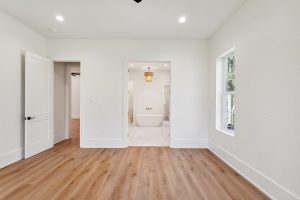Mastering Monochromatic Elegance in Transforming Spaces with Single-Material Themes
The latest trend in home design is captivating homeowners and designers alike with its simplicity and elegance. Single-material design, particularly in kitchens and bathrooms, is becoming increasingly popular for its ability to create a cohesive and visually striking space. This approach involves covering entire rooms – from floor to ceiling – in one continuous material, offering a modern take on traditional design aesthetics. Notable designers, including Chad James from Nashville and Megan Grehl from New York, have observed a growing demand for these unified spaces, particularly in areas where temperature resistance and durability are key.
The concept extends beyond mere aesthetics; it is about enhancing a room’s architecture and allowing the interplay of light to define the space throughout the day. However, implementing a single-material design requires a thoughtful approach to ensure that the space remains balanced and inviting. Here are some insights from industry experts on how to master this trend.
Designers emphasize the importance of tailoring material choices to the dimensions of the room. In smaller spaces, like powder rooms, a vibrant pattern can add depth and create the illusion of a larger area. In contrast, larger rooms can benefit from monochromatic colors and mixed textures within the same color palette to add interest without overwhelming the space.
Current trends lean towards monochromatic designs with bold colors. Inspired by the fashion industry, designers like Huma Sulaiman encourage homeowners to consider vibrant hues as neutral backdrops that allow furniture and décor to stand out. Whether you opt for furniture that contrasts with the background or pieces that complement the overarching tone, the right color choice can transform your space into a stylish and cohesive environment.
When selecting materials for your single-surface room, consider how different textures interact with natural light. Variations between matte and polished finishes can significantly affect the room’s ambiance throughout the day. Observing how materials react to sunlight at different times can help avoid unwanted glare and create a more harmonious space.
Even within a single-material theme, there is room for creativity with patterns and scale. Planning the layout of patterns or combining different styles can enhance the room’s aesthetic without diverging from the unified theme. Companies like Cosentino offer collections like Dekton Pietra Kode, which provide the beauty of natural stone with unique patterns and textures, ideal for large-format applications.
To balance the hardness of the surfaces and avoid a sterile look, integrate soft furnishings and decorative elements. Wallpaper, linen towels, and cozy rugs can add warmth and texture to a room dominated by hard materials. Choosing decor in the same color family as the main material can ensure cohesion, while contrasting elements can serve as focal points and add layers of interest.
Adopting a single-material design can make a bold statement and transform a conventional space into a stunning and unified environment. By considering space, color, light, pattern, and complementary decor, homeowners can create a timeless and sophisticated look that highlights both the beauty and functionality of their rooms.









